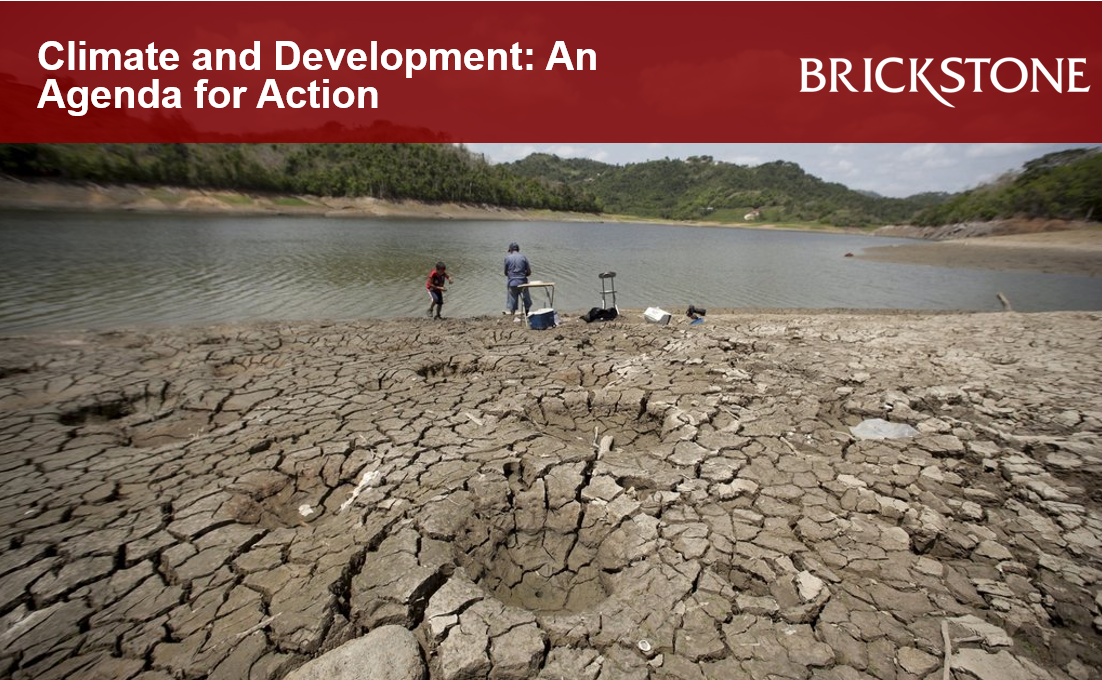Climate and Development: An Agenda for Action
Climate change poses a major threat to long-term development objectives, especially poverty reduction, and as a result, urgent accelerated climate and development actions are needed in reducing emissions particularly in high-income and other high-emitting countries. According to the World Bank, reducing emissions can be done without comprising development: taken together, CCDR low-carbon development strategies reduce emissions by 70%, without significant impact on growth, provided that policies are well designed and financing is available.
Also, financing needs an average of 1.4 percent of GDP, a manageable amount with appropriate private sector involvement. But in lower-income countries, financing needs can exceed 5 percent, which will require more support from high-income countries, including increased concessional resources.
This article by Brickstone reviews the World Bank’s report on Climate and Development: An Agenda for Action, highlighting key facts and insights.
Facts and Insights from Climate and Development: An Agenda for Action
Climate change represents a major global challenge, threatening the lives and livelihoods of over 100 million in extreme poverty as it exposes countries to exponential collateral damages, which poses risks to economies, infrastructure investments, water and food systems, public health, agriculture, and livelihoods. It also poses a threat to long-term development objectives, especially for developing countries as they face a unique challenge of having to achieve their economic development goals in the context of a changing climate.
Climate change affects all environmental conditions in which people live and economies operate, with complex direct and indirect impacts on activities and well-being. The future impacts of climate change critically depend on the choices we make today.
The need for ambitious climate action is heightened as a result of these adverse effects, and without drastic intervention and actions taken, climate change will remain an existential threat. In fact, it is projected to cause more devastating global consequences in the years to come. As a way forward, climate change experts have over the years identified the key drivers causing these planetary-scale changes, and as well, recommended various measures to curb this situation. These measures have formed the core of global and national climate change goals and actions.
The Climate and Development: An Agenda for Action is a publication published by the World Bank, identifying emerging insights from World Bank Group 2021-22 Country Climate and Development Reports.
The following are key facts and insights from the World Bank’s Climate and Development: An Agenda for Action publication:
To curb climate change and its impact, it is urgent that countries build the resilience and adaptation of their people and economies to the effects of climate change in their development strategies, while also reducing GHG emissions to mitigate damaging changes to the global public good that is climate. The World Bank affirms that with the appropriate adaptation policies, countries can reduce impacts in the short term. However, successful development requires rapid reductions in global GHG emissions, which requires first and foremost accelerated mitigation action in high-income countries and other large emitters.
Boosting resilience and adaptation is an urgent and integral part of development and poverty reduction, especially in low-income countries. The World Bank affirms that countries can achieve greater resilience through a three-pronged approach. This involves: first, rapid and inclusive development, especially poverty reduction and universal access to infrastructure and social services; second, a whole-of-society approach to resilience and adaptation, to ensure climate risks are considered in all decisions and investments; and third, a set of targeted sectoral interventions covering human capital, infrastructure, and various economic sectors.
According to the World Bank, Climate change objectives can be achieved without compromising development, but only if key conditions are met. These key conditions include well-designed climate actions, strong participation of the private sector, adequate international support, and appropriate complementary measures to manage unavoidable trade-offs, protect poor people’s consumption, and facilitate a just transition. Most CCDR low-carbon development pathways are more ambitious than existing NDCs, reducing total GHG emissions in CCDR countries by 70% compared with a current-policy scenario. Taken together, however, they would still lead to significant emissions in 2050, showing the need to adjust these pathways to increase ambition over time, but also for enhanced support from and action in HICs, including with negative emissions.
Successful climate change action requires challenging policy reforms, reallocation of scarce public resources, increased mobilization of private capital, and increased financial support from the international community. Resilient and low-carbon pathways can deliver net economic gains, if additional annual investment needs averaging 1.4 percent of countries’ GDP over 2022–30 can be met. The transition also requires managing political economic obstacles; strengthening institutions; accelerating diffusion of new technologies; and managing distributional outcomes. To be successful, all countries will require carefully designed policies and scaled-up financial support from richer economies. Low- income countries face higher investment needs, often exceeding 5 percent, and will need access to sustained levels of concessional resources, including grants.
Cleaner and more efficient technologies are often more productive and less expensive than fossil-fuel technologies, and the barriers to more resilient and lower-carbon development are also barriers to economic transformation and economic growth. The shift toward low-carbon development scenarios tends to moderately increase the present value of the system costs—that is, the fixed cost of new generation and storage and the variable costs of producing electricity—but the increase in upfront capital cost rises much more substantially, making financing a major challenge in the transition. However, sectoral transitions as such, with private sector mobilization create opportunities to reduce GHG emissions while contributing to development.
Resilient and low-carbon pathways can deliver net economic gains. But they will not be realized without improved and sustained access to finance and mobilization of private capital to meet additional annual investment needs averaging 1.4 percent of countries’ GDP over 2022–30 in all CCDRs and 8 percent in low-income CCDR countries. The transition to more resilient and lower-carbon development also requires managing political economic obstacles, strengthening institutional capacity, accelerating diffusion of new technologies, and careful management of negative distributional outcomes. To overcome these challenges and achieve a just transition, all countries will require carefully designed policies and reforms and scaled-up financial support from richer economies.
According to the World Bank, prioritization and sequencing is a requisite for achieving successful climate development goals. The CCDRs identify country-specific priority actions and interventions that would either deliver immediate development benefits or whose delay would create lock-in effects or larger costs in the future. These priorities, which cover all sectors and include both adaptation and mitigation, demonstrate the importance of mainstreaming climate change into macroeconomic and sectoral policies, regulations, and investments.
Download the full publication here.






